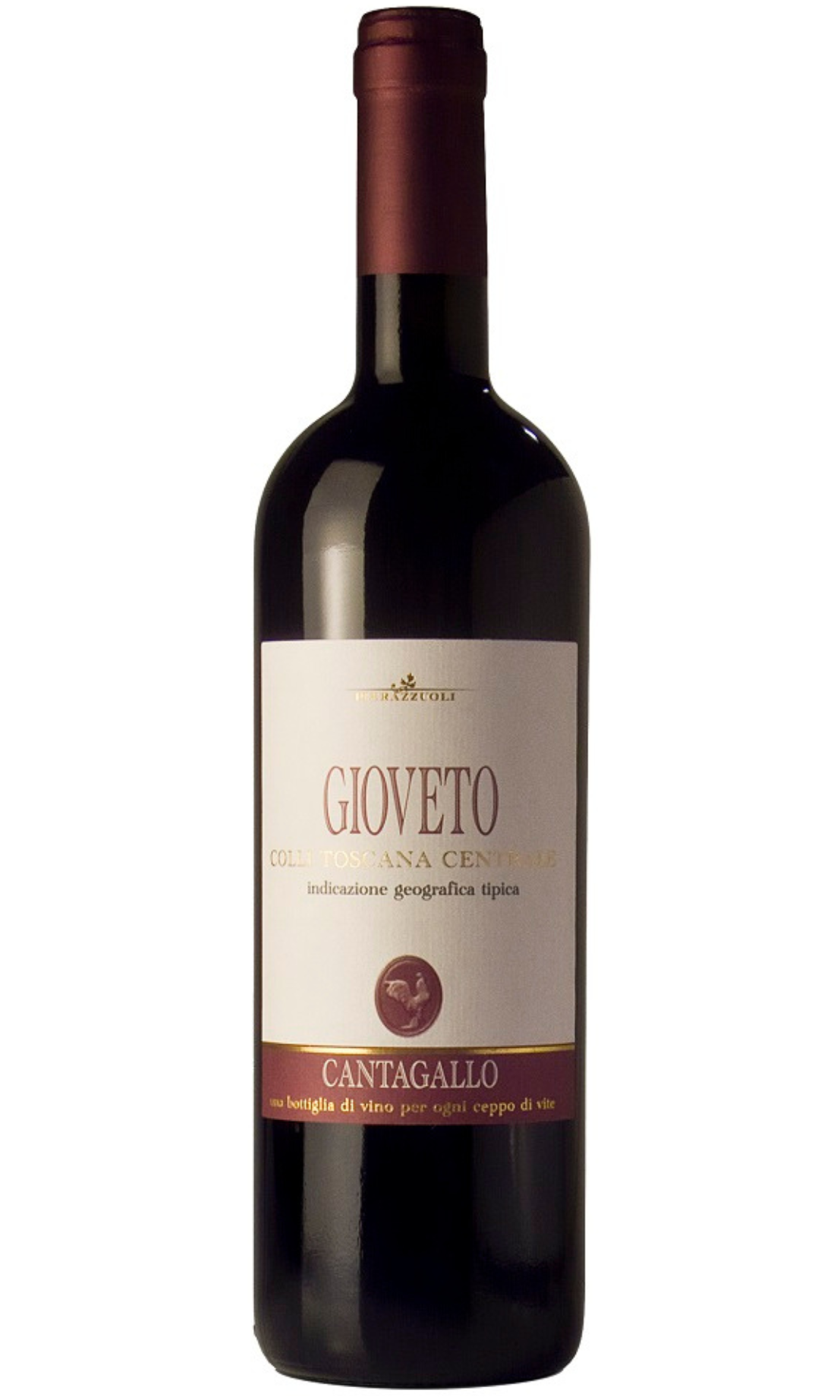Tenuta Cantagallo, 'Gioveto' Rosso Toscana 2021
Tenuta Cantagallo, 'Gioveto' Rosso Toscana 2021 is backordered and will ship as soon as it is back in stock.
A Supertuscan that really is very Super indeed!
Made from old vines Sangiovese and 20% each Syrah and Merlot, this wine is glossy, dark, sophisticated and very, very tasty. Full of blackberry, cherry and plum, the palate leads to tobacco and cinnamon in an effortlessly smooth delivery.
Incredible with game, this is also a delight with any slow-cooked dishes or simply cheeses and charcuterie.
The Merlot and Syrah plots for this wine are very clearly designated on the estate and are situated to enable them to ripen fully in colour, tannin and flavour without getting to be too high in sugar levels, retaining some degree of freshness. In this manner they achieve a wonderful balance that facilitates the generosity of fruit with drinkability and charm.
After a traditional fermentation the wine is aged in second and third-use French barriques for one year and then a further year in bottle.
92 Points from Wine Spectator.
Brothers Dario and Enrico farm this land and make the wine (Dario in the winery and Enrico in the vines) that their father bought in 1970. The family were cloth merchants but wanted to leave the busy business world when going home and a quiet Tuscan estate away from the tourism and competition of the Chianti Classico region, seemed to be the perfect thing for them. It is an estate that covers about 200 hectares and has some of the best olive groves in the whole of Tuscany. The vines are ages from 10-40 years and are almost exclusively Sangiovese, with some Syrah and Merlot planted for this wine of course, 'Gioveto'. The soils are tufferous and soft marl that really yield nothing except for the vine and olive tree in the manner of that miraculous of Mediterranean gift, and, as the vines face south and west, there is never any issue with ripening.
It was often said when I was growing up that all sunshine makes a desert. Though I know it's true, I often felt that it was proffered to quickly: that my observation that "their grass looks greener over there" deserved a little bit of a look. Certainly more than my parents were willing to give. Whether it was the standard of living and social cohesion found in Scandinavian countries, or simply better weather in France, I was often put back in my box and told that we were absolutely fine where we were. As an adult, I have come to reappraise this old Arabic saying and have been able to see, again, though it is true, that there are indeed some places on earth that manage to maintain nature's balance, while giving just a little bit more in areas that I care for. Namely, Italy and specifically Tuscany.
Social cohesion, taxation balance, standard of living within a generally buoyant economy may not be policy out-workings that are championed here in Italy, but for natural beauty, climate, suitability for all kinds of agriculture and the propagation of the grape vine, Tuscany and its wonderful hills really is one of the most blessed places in the world.
You might argue that Tuscans have known this for centuries and that this has made them arrogant and has pushed the prices of all their goods (wine included) far beyond what is fair; but I will offer that there are still nuggets to be found: not every winery is an historic palace-owning sinecure, or a vast, corporate juice-machine. Nor are all of the rest of the Tuscan wineries niche extremists charging case prices per bottle. There are still those who may be in lesser-known regions who make wines from the grapes that they grow in a style appropriate to their place of origin.
I have a great chum in Chianti Classico and one day he introduced to one of his friends, Dario Pierazzuoli. "Where is the winery based?" I asked, "North Tuscany, but don't worry, it's really very good; I won't recommend you bad wines" answered my friend, putting me slightly on edge with a sense that I might be get from buying a second-hand car... But then I met this chap and tasted his wines.
There were instantly two things I was struck by: 1. He is incredibly witty; like a panel-show comedian that makes all the other guests look second-rate; he's quick, appropriate and warm, and genuinely interested in whoever he is with, making you feel comfortable, relaxed and valued. An extraordinary quality that he really wears on his sleeve. 2. The wines - which are wonderfully clean, vibrant and become progressively complex one after the next - were incredibly cheap. I was actually stuck for words and wasn't entirely sure what reaction was best: I'm well-adept at managing over-priced wineries and fairly good at managing poor quality wineries too. But this was new ground as the wines are delicious, balanced and off the beaten track, offering exceptional value for money.
And it is literally new ground for many of us, as the two wineries that the family own are in a part of Tuscany that is often overlooked. The wines come from two DOCGs at the very north boundaries of Chianti, between Florence and Empoli to the west and south, on the way to Pisa and Livorno. There is a run of sleepy villages that are on the edge of everything: relevance, train lines, borders, regions, thoroughfares and mountain ranges. Vitolini, Ginestra, Fibbiana; Spicchio, Lazzeretto, Vinci. (As in, Leonardo's hometown, which is nearly empty barring a very lovely, simplistic museum.) These places seem remote and stuck in the pages of bygone tomes of historic tales, overshadowed by the endless charms and modern capabilities of industrialised cities and busy-ness of Florence, Pisa and Sienna. Maybe for them, the sunshine of Tuscany has indeed made a desert. Or maybe not... The region in which Dario lives, on the south face of the hill of Montalbano, from which it takes its name, is a place full of possibility.
Chianti and its seven subzones were established into an overall Chianti region, defining the borders for where its grapes can be grown and the manner in which it must be made, in 1716 by Cosimo di Medici the third. On the same Bando (the piece of paper that was issued) he created the appellations of Carmignano, Pomino and Val d'Arno. The precursor for the appellation system we know today.
Production on the slopes of Montalbano has been recorded since the 13th century, but amphorae and wine making paraphernalia dating to 50AD have been found in tombs in the hills. It's part of the incredible history that this land has had, and though the recent glory of Chianti Classico hasn't spread this far, it is still very much part of the broader history. Today Chianti Montalbano accounts for a meagre 0.46% of the area and 0.49% of the production of the entire of the Chianti region and this is of course not a wine of the DOCG Montalbano, making it even more of a scarcity. I think that these wines punch far above their weight and certainly deserve more time in the spotlight.
Region: Tuscany
Country: Italy
Grape(s): Syrah, Sangiovese, Merlot, Cabernet Sauvignon
Style: Vibrant, Svelte, Structured, Smooth, Silky, Rich, Perfumed, Medium Full, Juicy, Iconic, Fruity, Engaging, Elegant, Dark, Complex, Broad, Balanced
Best food matches: Wild Boar, Venison, Veal, Tapas, Steak, St Stephen's Day, Spicy, Roasts, Ribs, Red Meats, Poultry, Pizza, Mature Cheeses, Lamb, Hard Cheeses, Grills, Game, Fine Dining, Duck, Christmas Dinner, Cheeses, Charcuterie, Casseroles, Cajun, Beef, Barbecue
Alcohol: 14.5%
Why buy from us?
When you buy wine from The Allotment you're helping a small Irish company that in turn supports small, sustainable wine producers who grow the grapes and make amazing wines. We only work with partners who share a deep respect and connection with the land and its traditions, witnessed in a firm commitment to quality and sustainability. All of which makes for better wines.




